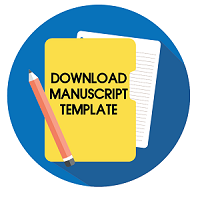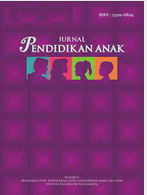Meningkatkan attensi belajar siswa kelas awal melalui media visual
Asep Supena, Universitas Negeri Jakarta, Indonesia
Nandang Hidayat, Universitas Pakuan, Indonesia
Abstract
Penelitian literatur ini bertujuan untuk mencari solusi terkait dengan upaya meningkatan perhatian siswa khususnya ditingkat awal yaitu kelas 1, 2 dan 3 terhadap tugas belajarnya selama proses pembelajaran berlangsung menggunakan media pembelajaran visual. Penelitian ini menggunakan metode tinjauan literatur integratif. Metode ini menggabungkan berbagai artikel berbasis empiris dan penelitian, buku, dan literatur lain yang dipublikasikan tentang penggunaan media visual dalam meningkatkan perhatian belajar siswa kelas awal tersebut. Penelitian literatur ini menyimpulkan: (1) Perhatian adalah proses pemilihan informasi yang dikontrol secara sukarela oleh subjek (sadar), atau dapat karena pengaruh beberapa peristiwa eksternal yang ditangkap indera (tidak sadar); (2) Proses perhatian terjadi melalui seleksi, kesadaran, dan control; (3) Model media visual yang digunakan sebaiknya bervariasi baik media pembelajaran yang dibuat oleh guru maupun media dari internet. Media visual dalam bentuk infografis merupakan model media visual yang paling disarankan; (4) Implikasi dari fungsi media visual terhadap memori penginderaan antara lain: (a) memori pengindera hanya dapat mengolah informasi dalam jumlah terbatas, sehingga media visual yang digunakan untuk menyajikan materi pembelajaran perlu didesain sedemikian sehingga informasi-informasi kunci dapat diterima oleh siswa dengan baik; (b) memori penginderaan yang memiliki daya serap paling tinggi adalah indera penglihatan, sehingga mengkombinasikan sajian informasi visual dapat meningkatkan jumlah informasi yang mampu diterima oleh memori pengindera.
Abstract
This literature research aims to find solutions related to efforts to increase the attention of students, especially at the initial level, grades 1, 2 and 3 of their learning tasks during the learning process takes place using visual learning media. This study uses the method of review of integrative literature. This method combines various empirical and research-based articles, books, and other published literature on the use of visual media in increasing the attention of students learning in the early grades. This literature research concludes: (1) Attention is the process of selecting information that is voluntarily controlled by the subject (conscious), or it can be due to the influence of some external events that are sensed (unconscious); (2) The process of attention occurs through selection, awareness, and control; (3) The visual media model used should vary both the learning media made by the teacher and the media from the internet. Visual media in the form of infographics is the most recommended visual media model; (4) The implications of the function of visual media on sensing memory include: (a) memory sensors can only process information in a limited amount, so that the visual media used to present learning material needs to be designed so that key information can be received properly by students; (b) sensing memory that has the highest absorption power is the sense of sight, so combining visual information offerings can increase the amount of information that the sensory memory can receive.
Keywords
Full Text:
Fulltext PDFReferences
Arsyad, A. (2005). Media pembelajaran. Jakarta: Raja Grafindo Persada.
Arvidson, P. S. (2003). A lexicon of attention: From cognitive science to phenomenology. Phenomenology and the Cognitive Sciences. https://doi.org/10.1023/A:1024895827774
Atkinson, R. C., & Shiffrin, R. M. (2016). Human memory: A proposed system and its control processes. Scientists Making a Difference: One Hundred Eminent Behavioral an Brain Scientists Talk about their Most Important Contributions. https://doi.org/10.1017/CBO9781316422250.025
Attwell, D., & Laughlin, S. B. (2001). An energy budget for signaling in the grey matter of the brain. Journal of Cerebral Blood Flow and Metabolism. https://doi.org/10.1097/00004647-200110000-00001
Bhinnety, M. (2008). Struktur dan proses memori. Yogyakarta: Universitas Gadjah Mada. https://doi.org/10.22146/bpsi.7375
Bruning, R. H., Schraw, G. J., & Norby, M. M. (2011). Cognitive psychology and instruction. History of Science. https://doi.org/10.2307/1421580
Callahan, J. L. (2010). Constructing a manuscript: Distinguishing integrative literature reviews and conceptual and theory articles. Human Resource Development Review. https://doi.org/10.1177/1534484310371492
Cardoso-Leite, P., & Bavelier, D. (2014). Video game play, attention, and learning: How to shape the development of attention and influence learning? Current Opinion in Neurology. https://doi.org/10.1097/WCO.0000000000000077
Carrasco, M., Ling, S., & Read, S. (2004). Attention alters appearance. Nature Neuroscience. https://doi.org/10.1038/nn1194
Chun, M. M., & Wolfe, J. (2001). Visual attention. In E. B. Goldstein (Ed.), Blackwell’s handbook of perception (pp. 272–310). Oxford, UK: Blackwell.
Cohen, R. A. (2014). Attention. In Encyclopedia of the Neurological Sciences. https://doi.org/10.1016/B978-0-12-385157-4.00450-4
Driver, J. (2001). A selective review of selective attention research from the past century. British Journal of Psychology. https://doi.org/10.1348/000712601162103
Gabrieli, J. D. E. (1998). Cognitive neuroscience of human memory. Annual Review of Psychology. https://doi.org/10.1146/annurev.psych.49.1.87
Gardiner, J. M., & Parkin, A. J. (1990). Attention and recollective experience in recognition memory. Memory & Cognition. https://doi.org/10.3758/BF03197100
Hermawan, H., Samsuri, S., Kurniawati, D., Sofyaningsih, V., & Prasetyo, D. (2018). The use of controversial public issues with video and macromedia flash player media in civic education learning. Psychology, Evaluation, and Technology in Educational Research, 1(1), 19-30. doi:http://dx.doi.org/10.33292/petier.v1i1.2
Huang, T., Le, V., Paine, T., Khorrami, P., & Tariq, U. (2014). Visual media: history and perspectives. IEEE Multimedia. https://doi.org/10.1109/MMUL.2014.35
Jatmika, H. M. (2015). Pemanfaatan media visual dalam menunjang pembelajaran pendidikan jasmani di sekolah dasar. Jurnal Pendidikan Jasmani Indonesia, 3(1). doi:https://doi.org/10.21831/jpji.v3i1.6176
Kolb, B., & Whishaw, I.Q. (2014). Fundamentals of human neuropsychology. UNK. https://doi.org/10.1055/s-2006-947280
Lankow, J., Ritchie, J., Crooks, & Ross. (2014). Infografis: Kedahsyatan cara bercerita visual. Jakarta: Gramedia Pustaka Utama.
Lee, J., Lin, L., & Robertson, T. (2012). The impact of media multitasking on learning. Learning, Media and Technology. https://doi.org/10.1080/17439884.2010.537664
Mohd, S. N., & Muhammad, S. S. (2006). Kemahiran visualisasi: Kemahiran kognitif tahap tinngi dalam pendidikan teknik dan vokasional. Seminar Kebangsaan Pendidikan Teknik Dan Voksional 2006.
Moscovitch, M. (1992). Memory and Working-with-Memory: A Component Process Model Based on Modules and Central Systems. Journal of Cognitive Neuroscience. https://doi.org/10.1162/jocn.1992.4.3.257
Nusir, S., Alsmadi, I., Al-Kabi, M., & Sharadgah, F. (2013). Studying the impact of using multimedia interactive programs on children’s ability to learn basic math skills. E- Learning and Digital Media. https://doi.org/10.2304/elea.2013.10.3.305
Petersen, S. E., & Posner, M. I. (2012). The Attention System of the Human Brain: 20 Years After. Annual Review of Neuroscience. https://doi.org/10.1146/annurev-neuro-062111-150525
Piran, W., & Sasonoharjo. (2002). Media pembelajaran. Jakarta: LAN RFI.
Posner, M. I. (1993). Interaction of arousal and selection in the posterior attention network. In A. D. Baddeley & L. Weiskrantz (Eds.), Attention: Selection, awareness, and control: A tribute to Donald Broadbent (pp. 390-405). New York, NY, US: Clarendon Press/Oxford University Press
Purwatininghandayani, S., Wahyuni, A., & Azis, D. (2019). Penerapan pembelajaran picture and picture untuk meningkatkan motivasi dan prestasi belajar siswa sekolah dasar. Teacher in Educational Research, 1(1), 18-26. doi:http://dx.doi.org/10.26486/tere.v1i1.6
Roda, C., & Thomas, J. (2006). Attention aware systems: Theories, applications, and research agenda. In Computers in Human Behavior. https://doi.org/10.1016/j.chb.2005.12.005
Schmidt, M. E., & Vandewater, E. A. (2008). Media and attention, cognition, and school achievement. Future of Children. https://doi.org/10.1353/foc.0.0004
Schraw, G., & McCrudden, M. (2013). Information processing theory. ducation.com. https://doi.org/10.4135/97814129524 84.n349
Supardi, S., Leonard, L., Suhendri, H., & Rismurdiyati, R. (2015). Pengaruh media pembelajaran dan minat belajar terhadap hasil belajar fisika. Formatif: Jurnal Ilmiah Pendidikan MIPA, 2(1). doi:http://dx.doi.org/10.30998/formatif.v2i1.86
Thahir, A. (2014). Psikologi belajar: Buku pengantar dalam memahami psikologi belajar. http://repository.radenintan.ac.id/845/ 1/Buku_Psikologi_Belajar_Andi_Tha hir.pdf
Treue, S., & Katzner, S. (2010). Visual attention. Encyclopedia of Neuroscience. https://doi.org/10.1016/B978-008045046-9.00242-4
Wahyudin, W., Sutikno, S., & Isa, A. (2016). Keefektifan pembelajaran berbantuan multimedia menggunakan metode inkuiri terbimbing untuk meningkatkan minat dan pemahaman siswa. Jurnal Pendidikan Fisika Indonesia, 6(1). https://doi.org/10.15294/jpfi.v6i1.1105
DOI: https://doi.org/10.21831/jpa.v8i1.22657
Refbacks
- There are currently no refbacks.
Copyright (c) 2019 Jurnal Pendidikan Anak

This work is licensed under a Creative Commons Attribution-ShareAlike 4.0 International License.
Our Journal indexed by:
Supervised by:
Jurnal Pendidikan Anak is licensed under a Creative Commons Attribution-ShareAlike 4.0 International License.
Based on a work at https://journal.uny.ac.id/index.php/jpa.
Jurnal Pendidikan Anak Stats















